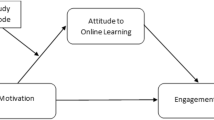Abstract
The purpose of this study is to estimate the effects of organizational attributes on social integration in particular, and more generally on the student withdrawal process. Theory elaboration (the application of new concepts borrowed from other theoretical perspectives to explain the focal phenomenon) is used to help with the revision of Tinto's interactionalist theory of individual student departure. The existence of empirical evidence supporting the importance of organizational attributes in the persistence process makes the addition of organizational characteristics a logical choice as a possible source of social integration in an elaboration of Tinto's theory. The results from this study provide strong support for elaborating the revised version of Tinto's theory through the inclusion of concepts from organizational theory. The findings from this study also indicate that future research should use theory elaboration to look for other potential sources of social integration.
Similar content being viewed by others
REFERENCES
Astin, A. W., and Scherrei, R. (1980). Maximizing Leadership Effectiveness. San Francisco: Jossey-Bass.
Baird, L. (1988). The college environment revisited: A review of research and theory. In J. Smart (ed.), Handbook of Theory and Research in Higher Education, vol. 4 (pp. 1–52). New York: Agathon.
Bean, J. P. (1980). Dropouts and turnover: The synthesis and test of a causal model of student attrition. Research in Higher Education 12: 155–187.
Bean, J. P. (1983). The application of a model of turnover in work organizations to the student attrition process. Review of Higher Education 12: 155–182.
Bean, J. P., and Metzner, B. S. (1985). A conceptual model of nontraditional undergraduate student attrition. Review of Educational Research 55(4): 485–540.
Birnbaum, R. (1988). How Colleges Work. San Francisco: Jossey-Bass.
Bolman, L. G., and Deal, T. E. (1992). Reframing Organizations: Artistry, Choice, and Leadership. San Francisco: Jossey-Bass.
Braxton, J. M., and Brier, E. M. (1989). Melding organizational and interactional theories of student attrition: A path analytic study. Review of Higher Education 13(1): 47–61.
Braxton, J. M., Sullivan, A. S., and Johnson, R. (1997). Appraising Tinto's theory of college student departure. In J. Smart (ed.), Higher Education: Handbook of Theory and Research, vol. 12 (pp. 107–164). New York: Agathon.
Braxton, J. M., Vesper, N., and Hossler, D. (1995). Expectations for college and student persistence. Research in Higher Education 36(4): 595–612.
Cabrera, A. F., Castaneda, M. B., Nora, A., and Hengstler, D. (1992). The convergence between two theories of college persistence. Research in Higher Education 33: 571–593.
Eckland, B. (1964). College dropouts who come back. Harvard Educational Review, 34.
Kamens, D. H. (1971). The college a “charter” and college size: Effects on occupational choice and college attrition. Sociology of Education 44(summer) 270–296.
McDonough, P. M. (1994). Buying and selling higher education: The social construction of the college applicant. Journal of Higher Education 65(4): 427–446.
Meyer, J. W. (1970). The charter: Conditions of diffuse socialization in schools. In W. R. Scott (ed.), Social Processes and Social Structures: An Introduction to Sociology. New York: Henry Holt.
Pascarella, E. T. (1985). College environmental influences on learning and cognitive development: A critical review and synthesis. In J. Smart (ed.), Handbook of Theory and Research in Higher Education vol. 1 (pp. 1–61). New York: Agathon.
Pascarella, E. T., and Terenzini, P. T. (1980). Predicting freshman persistence and voluntary dropout decisions from a theoretical model. Journal of Higher Education 51(1): 60–75.
Pascarella, E. T., Duby, P. B., and Iverson, B. K. (1983). A test and reconceptualization of a theoretical model of college withdrawal in a commuter institution setting. Sociology of Education 56: 88–100.
Pedhauzer, E. J. (1982). Multiple Regression in Behavioral Research: Explanation and Prediction, 2nd. ed. New York: Holt, Rinehart & Winston.
Spady, W. (1971). Dropouts from higher education: Toward an empirical model. Interchange 2: 38–62.
Thornberry, T. P. (1989). Reflections on the advantages and disadvantages of theoretical integration. In S. F. Messner, M. D. Krohn, and A. E. Liska (eds.), Theoretical Integration in the Study of Deviance and Crime (pp. 51–60). Albany: State University of New York Press.
Tinto, V. (1975). Dropout from higher education: A theoretical synthesis of recent research. Review of Educational Research 45: 89–125.
Tinto, V. (1986). Theories of student departure revisited. In J. Smart (ed.), Higher Education: A Handbook of Theory and Research, vol. 2 (pp. 359–384). New York: Agathon.
Tinto, V. (1993). Leaving College: Rethinking the Causes and Cures of Student Attrition, 2nd ed. Chicago: University of Chicago Press.
Voorhees, R. A. (1987). Toward building models of community college persistence: A logit analysis. Research in Higher Education 26(2): 115–129.
Wolfle, L. N., and Ethington, C. (1985). A program for standard errors of indirect effects in recursive causal models. Educational and Psychological Measurement, Spring: 161–166.
Rights and permissions
About this article
Cite this article
Berger, J.B., Braxton, J.M. REVISING TINTO'S INTERACTIONALIST THEORY OF STUDENT DEPARTURE THROUGH THEORY ELABORATION: Examining the Role of Organizational Attributes in the Persistence Process. Research in Higher Education 39, 103–119 (1998). https://doi.org/10.1023/A:1018760513769
Issue Date:
DOI: https://doi.org/10.1023/A:1018760513769




